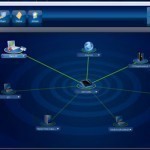Switches represent the features and technologies that can be used to respond to the requirements in emerging network design. Some basic operations and technologies of switches are as follows: Fast Convergence: Switches stipulate that the network must adapt quickly to network topology changes. Deterministic Paths: Switches provide desirability of a given path to a destination for certain applications or user groups. Deterministic Failover: Switches specify that a mechanism be in place to ensure that the network is operational all the times. Scalable Size and Throughput: Switches provide the infrastructure that must handle the increased Read More
Cisco Network Management

Cisco Network Management Overview of Network Management Different people may take network management as different meanings. It may be considered as solitary network consultant for monitoring network activity using outdated protocol analyzer. While network management in distributed database environment, managing network nodes for generating real time graphics and auto polling of network devices. There are number of tools and applications which are used for network management to support network administrators to monitor and maintain networks of all types. In the early 1980s remarkable growth in field of network deployment was Read More
The Cisco Three Layer Hierarchical Model vs the OSI Model
The ISO, International Organization for Standardization is the Emily Post of the network protocol world. Just like Ms. Post, who wrote the book setting the standards or protocols for human social interaction, the ISO developed the OSI model as the precedent and guide for an open network protocol set. Defining the etiquette of communication models, it remains today the most popular means of comparison for protocol suites. OSI layers are defined as top down such as: The Application layer The Presentation layer The Session layer The Transport layer The Network Read More
Spanning Tree Protocol
Redundant Topology A Local Area Network may consist of more than one segment. Each segment of the LAN connected through a separate physical device mostly switch. Switches use their uplink ports to connect different segments. The LAN administrator can connect the switches with each other through more than one uplink port using redundant topology. Redundant topology eliminates the single point of failure and that will improve the performance of network. Overall redundant topology is a good solution for making a LAN efficient but there are some drawbacks of redundant topology. Read More
Understanding the Cisco Three-Layer Hierarchical Model
Understanding the Cisco Three-Layer Hierarchical Model Hierachical network design helps us to make networks more reliable and predictable. Level by level design help to understand networking factions easily like, we can use tools like access lists at specific level and can avoid them from others. Cisco layer model consist of the following three layers. The Core layer The Distribution layer The Access layer Each layer plays a role and specific responsibilities are assigned to these three logical layers. These layers are same like the network layers of OSI reference model. Read More


Share on: